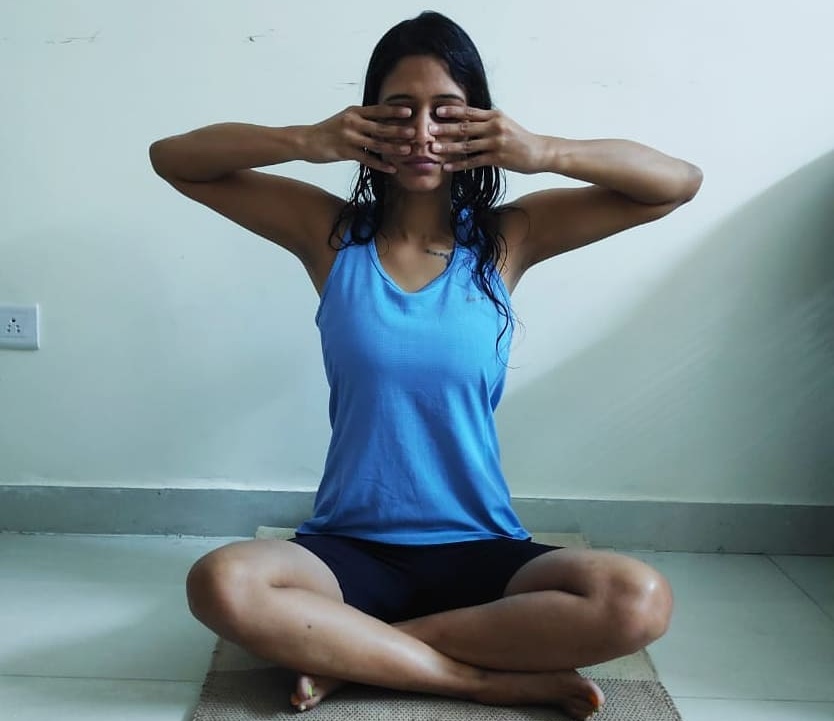
Shanmukhi mudra is performed by using the fingers to close the six openings of the face (two eyes, two ears, nostrils, and mouth) through which we receive sensory input. It’s used in a yoga breathing exercise called Bhramari Pranayama.
By closing sensory inputs, shanmukhi mudra helps to withdraw the senses from external stimuli, allowing the mind to turn inward and focus on the present moment.
Shanmukhi Mudra is known to have several benefits for both physical and mental health. By allowing the mind to turn inward, it helps reduce anxiety, stress, and depression, improve concentration, memory, and overall cognitive function, and enhance respiratory function.
In this article, we will explore the meaning and use of Shanmukhi Mudra in yoga, how to do it correctly, practice tips, precautions to take, and any possible side effects.
What is Mudra in Yoga?
Mudra is a Sanskrit term which means ‘seal’, ‘mark’ or symbolically a ‘gesture’. It’s used in yoga to redirect the Prana (or vital life force) to different parts of the body. It works on the principle of the five elements of the body or Pancha Mahabhutas.
There are various types of mudras in yoga but the most common are hasta mudras or hand gestures. You can read more about different types of mudras here!
According to Ayurveda, our body is made of five great elements: Ether/space, air, fire, water and earth. In order to maintain good health and wellness, one needs to have a balance of five elements in the body.
Five fingers of our hands are switches for the five elements. Each finger represents one element.

Hand mudras use different gesture formations to manipulate the proportion of five elements within the body. It helps maintain good health and well-being by balancing the five elements of the body.
Also read: Fire element symbolism and use in our body
Shanmukhi Mudra

The name “Shanmukhi” is derived from the Sanskrit words “Shan” meaning six and “Mukhi” meaning face or opening, indicating the six openings or gateways of the face.
Shanmukhi mudra is performed with both hands closing the six openings on the face. To perform it, lift your hands up to your face level, palm facing your face. Now close your ear opening with the thumb tip, close your eyes with index fingertip over eyelids, partially block your nostrils on either side with your middle finger and place ring and little finger just above and below your lips to close your mouth.
Significance of Shanmukhi Mudra
Shanmukhi Mudra is considered a powerful practice for people with over-active minds who would like to develop a meditation practice.
This mudra withdraws the mind from the senses and turns it inward. When the mind is detached from the senses, it becomes easy to control them which leads to a state of deep relaxation and inner peace.
The five senses refer to the five main ways that we receive information from the world around us. Shanmukhi mudra blocks the five senses in the following manner:
- Sight (visual perception through the eyes) is blocked by the index finger
- Hearing (auditory perception through the ears) is blocked by the thumb
- Smell (olfactory perception through the nose) is blocked by the middle finger
- Taste (gustatory perception through the tongue) is blocked by the ring and little finger
- Touch (tactile perception through the skin) is blocked by the ring and little finger
When the senses are detached from the external world or more precisely “withdrawal of the senses”, it is called Pratyahara – the 5th in 8 limbs of yoga. Hence, shanmukhi mudra encourages Pratyahara, the ability to draw the energies of your senses inward. This inward focus allows the practitioner to become more aware of their thoughts and emotions, which can be helpful for managing stress, anxiety, and other mental health issues.
Furthermore, the practice of Shanmukhi Mudra with Bhramari pranayama enhances respiratory function and improves concentration and memory. Deep rhythmic breathing with a bee-like sound in this pranayama calms the mind and balances the flow of prana in the body, leading to greater physical and mental vitality.
Shanmukhi Mudra Benefits
- Increases focus and concentration: Shanmukhi Mudra is a powerful yoga mudra that helps to increase focus and concentration. It draws the mind inward, away from external stimuli, allowing the practitioner to concentrate better and improve mental clarity.
- Enhances skin health: Shanmukhi mudra increases blood circulation and oxygenation to the facial skin, promoting nourishment and a healthy complexion. It’s also beneficial in case of skin issues like acne and eczema.
- Improves ears functions: Regular practice of Bhramari pranayama with Shanmukhi mudra can help to reduce tinnitus or ringing in the ears, improve hearing capacity, and promote ear health. The sound vibrations created during the humming breath stimulate the auditory system and enhance ear functions.
- Enhances respiratory function: Shanmukhi Mudra can also enhance respiratory function by improving oxygen intake and promoting deep breathing. It can help reduce breathing difficulties and enhance overall respiratory health.
- Promotes emotional balance: Shanmukhi Mudra with Bhramari pranayama promotes emotional balance by creating subtle vibrations throughout the body. It can help release negative emotions such as anger, fear, and sadness and promote a sense of inner peace.
- Relieves anxiety and stress: Shanmukhi Mudra is an effective mudra for reducing anxiety and stress. It helps to calm the nervous system and reduce tension in the body, promoting a sense of calm and relaxation by closing the five senses.
- Enhances spiritual awareness: Shanmukhi Mudra enhances spiritual awareness by leading practitioners to Pratyahara. It helps to activate the third eye chakra, deepen the state of meditation, and connect with higher states of consciousness leading to Samadhi – the final stage of yoga.
Therapeutically one of the potential benefits of shanmukhi mudra is that it improves hearing function and cognitive function in patients with presbyacusis (age-related hearing loss) and dementia.
The practice of Shanmukhi mudra, along with Bhramari pranayama, has been found to have a positive impact on cognitive function in elderly individuals with presbycusis and dementia. The practice improved their cognitive performance in areas such as attention, memory, and language.
How to do Shanmukhi Mudra?
Remove glass or contact lenses. Sit in siddhasana, and take a deep breath in. Hold your breath and cover your ears with your thumbs, your eyes with your index fingers, and your nose with your middle fingers. Press your upper lip slightly over your bottom lip with your ring and little fingers. Gently exhale and slightly release finger pressure from their respective face openings.
Follow these step-by-step instructions to perform this mudra during meditation:
- Find a peaceful place and sit comfortably in a meditative position such as Padmasana, Sukhasana, or Vajrasana.
- Keep your back straight and align your head with the spine.
- Raise your arms and turn your palms towards your face. Make sure that your elbows are at shoulder level and the arms are parallel to the ground.
- Place the hands on your face with the fingers in the following positions:
- Thumb over the tragus, the appendage on the outside of the ear. Push the tragus inwards to close the ears.
- Index fingers over your eyelids with the tips touching the corner of the eyes.
- Middle fingers on the side of the nose. Gently press the nose to close it partially.
- Ring finger above the upper lip.
- Little finger below the lower lip.
- Take a deep inhale through the partially blocked nostrils. Hold your breath for as long as you can while completely closing your nostrils.
- Release the breath by exhaling slowly and fully.
While holding shanmukhi mudra, you can practice bhramari pranayama (humming bee breath) as it complements and enhances its effects. You can also engage in throat lock during the practice of this mudra.
When and How Long to Practice Shanmukhi Mudra?
Shanmukhi Mudra can be practiced at any time of the day, but it is recommended to practice with morning meditation 5 to 6 AM on an empty stomach. It is also suggested to practice this mudra in a quiet and peaceful environment to help with concentration and relaxation.
The duration of the practice can vary depending on your experience level and personal preferences. Beginners can start with 5-10 minutes and gradually increase the duration to 15-20 minutes as they become more comfortable with the practice.
After completion of the practice, remove your fingers in the same way you placed them, unblocking all your senses.
Precautions and Contraindications
Here are some precautions and contraindications to keep in mind:
- Beginners should try to avoid doing shanmukhi mudra for longer periods as it may cause strain in the arms or neck.
- One should pay close attention to their breath and make sure they are breathing deeply and evenly throughout the practice.
- Do not hold your breath in shanmukhi mudra pranayama in case of heart issues, blood pressure, migraine, asthma or any respiratory issues.
- Pregnant women should do shanmukhi mudra with low-pitch bhramari pranayama, not standalone practice.
- Avoid shanmukhi mudra if you have any ear or eye infections as covering your eye or ear with fingers can potentially worsen the infection or spread it to other parts of the body.
Conclusion
The Shanmukhi Mudra withdraws reactions and feelings from the outside world. It is used to manage stress, anxiety, and rage as well. If you consistently practice for a month, you’ll start to notice improvements in yourself. You can easily incorporate the Shanmukhi mudra into your daily routines or meditation sessions because learning it is simple.
Frequently Asked Questions about Shanmukhi Mudra
Shanmukhi mudra is also known as “six-part seal” or “seal of the six gates”. In some texts, it’s also mentioned as “Shanmukha Mudra”.
Shanmukhi mudra is often recommended to cure the symptoms of vertigo. It relaxes nerves and tissues in the face thereby improving the blood and energy flow towards the inner ear.
Shanmukhi Mudra gets its name from the ancient Sanskrit language, with “Shan” representing the number six and “Mukhi” signifying the face or opening. The name accurately reflects the mudra’s purpose, which involves covering the six openings or gateways of the face using specific finger placement.
Shanmukhi mudra stimulates nerve endings in the face, which can help relieve a lot of stress and tension. Regular practice of this mudra sharpens the intellect and promotes inner peace and serenity.
The post Shanmukhi Mudra: Benefits, How to Do It and More appeared first on Fitsri.